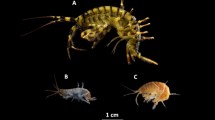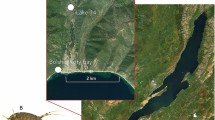Abstract
Temperature drives the metabolism of ectothermic organisms and impacts ecosystem functioning. Anthropogenic activities have been changing historical temperatures of freshwater ecosystems with a wide range of consequences for ecosystem processes such as leaf litter decomposition. Here we explored temperature effects on the performance of the amphipod Gammarus pseudolimnaeus, a dominant detritivore in its range. We first measured oxygen consumption under six temperatures and fitted a thermal performance curve which yielded an optimal range between 24 and 26°C. We then measured several organismal traits at four temperatures leading up to the determined optimal range. We quantified leaf litter mass loss (through feeding), somatic growth and survival under starvation at 7, 11, 17 and 23°C. Leaf litter loss was significantly lower only at the lowest temperature, with no detected differences among other treatments. Somatic growth rates increased with increasing temperature within the tested range. Organisms at warmer temperatures tended to die of starvation faster in comparison to those at colder temperatures. Our results suggest that warming may enhance leaf litter loss in certain parts of the year, but that warming could intensify organism mortality under starvation and compromise local population persistence.





Similar content being viewed by others
References
Agatz, A. & C. D. Brown, 2014. Variability in feeding of Gammarus pulex: moving towards a more standardised feeding assay. Environmental Sciences Europe 26: 1–9.
Angilletta, M. J., 2006. Estimating and comparing thermal performance curves. Journal of Thermal Biology 31: 541–545.
Angilletta, M. J., 2009. Thermal Adaptation: A Theoretical and Empirical Synthesis. Oxford University Press, Oxford.
Azevedo-Pereira, H. V. S., M. A. S. Graça & J. M. González, 2006. Life history of Lepidostoma hirtum in an Iberian stream and its role in organic matter processing. Hydrobiologia 559: 183–192.
Bärlocher, F. & B. Kendrick, 1973. Fungi in the diet of Gammarus pseudolimnaeus (Amphipoda). Oikos 24: 295–300.
Borgmann, U., 1996. Systematic analysis of aqueous ion requirements of Hyalella azteca: a standard artificial medium including the essential bromide ion. Archives of Environmental Contamination and Toxicology 30: 356–363.
Bousfield, E, 1958. Freshwater Amphipod Crustaceans of Glaciated North America. National Museum of Canada.
Bradford, M. A., B. Berg, D. S. Maynard, W. R. Wieder & S. A. Wood, 2016. Understanding the dominant controls on litter decomposition. Journal of Ecology 104: 229–238.
Bundschuh, M., J. P. Zubrod & R. Schulz, 2011. The functional and physiological status of Gammarus fossarum (Crustacea: Amphipoda) exposed to secondary treated wastewater. Environmental Pollution 159: 244–249.
Coulaud, R., O. Geffard, B. Xuereb, E. Lacaze, H. Quéau, J. Garric, S. Charles & A. Chaumot, 2011. In situ feeding assay with Gammarus fossarum (Crustacea): modelling the influence of confounding factors to improve water quality biomonitoring. Water Research 45: 6417–6429.
Daufresne, M., K. Lengfellner & U. Sommer, 2009. Global warming benefits the small in aquatic ecosystems. Proceedings of the National Academy of Sciences 106: 12788–12793.
Dieleman, W. I. J., S. Vicca, F. A. Dijkstra, F. Hagedorn, M. J. Hovenden, K. S. Larsen, J. A. Morgan, A. Volder, C. Beier, J. S. Dukes, J. King, S. Leuzinger, S. Linder, Y. Luo, R. Oren, P. De Angelis, D. Tingey, M. R. Hoosbeek & I. A. Janssens, 2012. Simple additive effects are rare: a quantitative review of plant biomass and soil process responses to combined manipulations of CO2 and temperature. Global Change Biology 18: 2681–2693.
Domingos, C., V. Ferreira, C. Canhoto & C. Swan, 2014. Warming, and the presence of a dominant shredder, drive variation in decomposer communities in a mountain stream. Aquatic Sciences 77: 129–140.
Dou, S. Z., R. Masuda, M. Tanaka & K. Tsukamoto, 2005. Effects of temperature and delayed initial feeding on the survival and growth of Japanese flounder larvae. Journal of Fish Biology 66: 362–377.
Fernandes, I., S. Seena, C. Pascoal & F. Cássio, 2014. Elevated temperature may intensify the positive effects of nutrients on microbial decomposition in streams. Freshwater Biology 59: 2390–2399.
Ferreira, V. & C. Canhoto, 2014. Effect of experimental and seasonal warming on litter decomposition in a temperate stream. Aquatic Sciences 76: 155–163.
Ferreira, V., A. L. Gonçalves, D. L. Godbold & C. Canhoto, 2010. Effect of increased atmospheric CO2 on the performance of an aquatic detritivore through changes in water temperature and litter quality. Global Change Biology 16: 3284–3296.
Foucreau, N., D. Cottin, C. Piscart & F. Hervant, 2014. Physiological and metabolic responses to rising temperature in Gammarus pulex (Crustacea) populations living under continental or Mediterranean climates. Comparative Biochemistry and Physiology Part A: Molecular & Integrative Physiology 168: 69–75.
Garzke, J., S. H. Ismar & U. Sommer, 2015. Climate change affects low trophic level marine consumers: warming decreases copepod size and abundance. Oecologia 177: 849–860.
González, J. & M. A. S. Graça, 2003. Conversion of leaf litter to secondary production by a shredding caddisfly. Freshwater Biology 48: 1578–1592.
Hairston, N. G., F. E. Smith & L. B. Slobodkin, 1960. Community structure, population control, and competition. American Naturalist: 421–425.
Hieber, M. & M. O. Gessner, 2002. Contribution of stream detritivores, fungi and bacteria to leaf breakdown based on biomass estimates. Ecology 83: 1026–1038.
Huey, R. B. & R. D. Stevenson, 1979. Integrating thermal physiology and ecology of ectotherms: a discussion of approaches. American Zoologist 19: 357–366.
Hynes, H. B. N. & F. Harper, 1972. The life histories of Gammarus lacustris and G. pseudolimnaeus in southern Ontario. Crustaceana 3: 329–341.
IPCC, 2013. Summary for Policymakers. Cambridge University Press, Cambridge, New York.
Irons, J. G. I., M. W. Oswood & J. P. Bryant, 1988. Consumption of leaf detritus by a stream shredder: influence of tree species and nutrient status. Hydrobiologia 160: 53–61.
Issartel, J., F. Hervant, Y. Voituron, D. Renault & P. Vernon, 2005. Behavioural, ventilatory and respiratory responses of epigean and hypogean crustaceans to different temperatures. Comparative Biochemistry and Physiology Part A: Molecular & Integrative Physiology 141: 1–7.
Jonsson, M., B. Malmqvist & P. O. Hoffsten, 2001. Leaf litter breakdown rates in boreal streams: does shredder species richness matter? Freshwater Biology 46: 161–171.
Kaufmann, K. W., 1981. Fitting and using growth curves. Oecologia 49: 293–299.
Klimant, I., M. Kühl, R. N. Glud & G. Holst, 1997. Optical measurement of oxygen and temperature in microscale: strategies and biological applications. Sensors and Actuators B: Chemical 38: 29–37.
Kooijman, S., 2010. Dynamic energy budget theory for metabolic organisation. Cambridge University Press, Cambridge.
Krenek, S., T. U. Berendonk & T. Petzoldt, 2011. Thermal performance curves of Paramecium caudatum: a model selection approach. European Journal of Protistology 47: 124–137.
Lactin, D. J., N. J. Holliday, D. L. Johnson & R. Craigen, 1995. Improved rate model of temperature-dependent development by arthropods. Environmental Entomology 24: 68–75.
Mas-Marti, E., I. Muñoz, F. Oliva & C. Canhoto, 2015. Effects of increased water temperature on leaf litter quality and detritivore performance: a whole-reach manipulative experiment. Freshwater Biology 60: 184–197.
McGurk, M. D., 1984. Effects of delayed feeding and temperature on the age of irreversible starvation and on the rates of growth and mortality of Pacific herring larvae. Marine Biology 84: 13–26.
Miller, S. A., 1984. Seasonal activity patterns of Gammarus pseudolimnaeus Bousfield (Amphipoda). Crustaceana 46: 135–147.
Missouri Department of Natural Resources. 2010. Total maximum daily load (TMDL) for Lake Taneycomo in Taney County, Missouri Jefferson City, MO.
Moenickes, S., A. K. Schneider, L. Muhle, L. Rohe, O. Richter & F. Suhling, 2011. From population-level effects to individual response: modelling temperature dependence in Gammarus pulex. Journal of Experimental Biology 214: 3678–3687.
Moghadam, F. S. & M. Zimmer, 2015. Effects of warming, nutrient enrichment and detritivore presence on litter breakdown and associated microbial decomposers in a simulated temperate woodland creek. Hydrobiologia 770: 1–14.
Nilsson, L. M., 1974. Energy budget of a laboratory population of Gammarus pulex (Amphipoda). Oikos 25: 35–42.
O’Connor, M. I., B. Gilbert & C. J. Brown, 2011. Theoretical predictions for how temperature affects the dynamics of interacting herbivores and plants. The American Naturalist 178: 626–638.
Ojanguren, A. F., F. G. Reyes-Gavilán & F. Braña, 2001. Thermal sensitivity of growth, food intake and activity of juvenile brown trout. Journal of Thermal Biology 26: 165–170.
Petter, G., M. Weitere, O. Richter & S. Moenickes, 2014. Consequences of altered temperature and food conditions for individuals and populations: a Dynamic Energy Budget analysis for Corbicula fluminea in the Rhine. Freshwater Biology 59: 832–846.
Poole, G. C. & C. H. Berman, 2001. An ecological perspective on in-stream temperature: natural heat dynamics and mechanisms of human-caused thermal degradation. Environmental Management 27: 787–802.
Pörtner, H.-O., 2010. Oxygen- and capacity-limitation of thermal tolerance: a matrix for integrating climate-related stressor effects in marine ecosystems. The Journal of Experimental Biology 213: 881–893.
Pörtner, H.-O. & A. P. Farrell, 2008. Physiology and climate change. Science 322: 690–692.
Postaski, L. L., G. M. Capelli & R. M. Chambers, 2013. Occurrence and distribution of the freshwater amphipods gammarus pseudolimnaeus and Gammarus fasciatus in Southeastern Virginia. Northeastern Naturalist 20: 609–623.
R Core Team, 2014. R: A Language and Environment for Statistical Computing. R Foundation for Statistical Computing, Vienna.
Rall, B. C., O. Vucic-Pestic, R. B. Ehnes, M. Emmerson & U. Brose, 2010. Temperature, predator-prey interaction strength and population stability. Global Change Biology 16: 2145–2157.
Roy, M., J. Brodeur & C. Cloutier, 2002. Relationship between temperature and developmental rate of Stethorus punctillum (Coleoptera: Coccinellidae) and its prey Tetranychus mcdanieli (Acarina: Tetranychidae). Environmental Entomology 31: 177–187.
Schneider, C. A., W. S. Rasband & K. W. Eliceiri, 2012. NIH Image to ImageJ: 25 years of image analysis. Nature Methods 9: 671–675.
Smith, W. E., 1973. Thermal tolerance of two species of Gammarus. Transactions of the American Fisheries Society 102: 431–433.
Sutcliffe, D. W., T. R. Carrick & L. G. Willoughby, 1981. Effects of diet, body size, age and temperature on growth rates in the amphipod Gammarus pulex. Freshwater Biology 11: 183–214.
Tank, J. L., E. J. Rosi-Marshall, N. A. Griffiths, S. A. Entrekin & M. L. Stephen, 2010. A review of allochthonous organic matter dynamics and metabolism in streams. Journal of the North American Benthological Society 29: 118–146.
Van Damme, R., D. Bauwens, A. Castilla & R. Verheyen, 1989. Altitudinal variation of the thermal biology and running performance in the lizard Podarcis tiliguerta. Oecologia 80: 516–524.
Vasseur, D. A. & K. S. McCann, 2005. A mechanistic approach for modeling temperature-dependent consumer-resource dynamics. The American Naturalist 166: 184–198.
Wallace, J. B., S. L. Eggert, J. L. Meyer & J. R. Webster, 1997. Multiple trophic levels of a forest stream linked to terrestrial litter inputs. Science 277: 102–104.
Acknowledgments
We thank Patrick Nitchals for his dedication to the model organism, Janna Vavra, Sadie Fisher and Anwesha Dey for their help with experimental work, and John DeLong for the use of the oxygen transmitter. Nika Galic was supported by the Program of Excellence in Population Biology of the School of Biological Sciences, University of Nebraska-Lincoln. We gratefully acknowledge Verónica Ferreira and several anonymous reviewers whose generous comments improved this manuscript.
Author information
Authors and Affiliations
Corresponding author
Additional information
Handling editor: Verónica Jacinta Lopes Ferreira
Rights and permissions
About this article
Cite this article
Galic, N., Forbes, V.E. Effects of temperature on the performance of a freshwater amphipod. Hydrobiologia 785, 35–46 (2017). https://doi.org/10.1007/s10750-016-2901-9
Received:
Revised:
Accepted:
Published:
Issue Date:
DOI: https://doi.org/10.1007/s10750-016-2901-9




